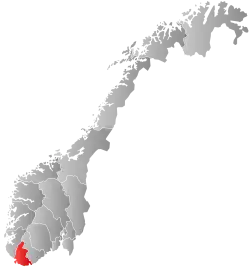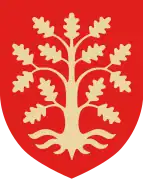Øvrebø og Hægeland Municipality
Øvrebø og Hægeland herred | |
|---|---|
 View of one of the local churches, Hægeland Church | |
 Vest-Agder within Norway | |
 Øvrebø og Hægeland within Vest-Agder | |
| Coordinates: 58°17′26″N 07°46′39″E / 58.29056°N 7.77750°E | |
| Country | Norway |
| County | Vest-Agder |
| District | Sørlandet |
| Established | 1 Jan 1865 |
| • Preceded by | Øvrebø Municipality |
| Disestablished | 1 July 1896 |
| • Succeeded by | Øvrebø and Hægeland municipalities |
| Administrative centre | Øvrebø |
| Area (upon dissolution) | |
| • Total | 303 km2 (117 sq mi) |
| Population (1896) | |
| • Total | 1,731 |
| • Density | 5.7/km2 (15/sq mi) |
| Time zone | UTC+01:00 (CET) |
| • Summer (DST) | UTC+02:00 (CEST) |
| ISO 3166 code | NO-1016[1] |
Øvrebø og Hægeland is a former municipality that was located in the old Vest-Agder county in Norway. The 303-square-kilometre (117 sq mi) municipality existed from 1865 until its dissolution in 1896. It was located in the northern part of the present-day municipality of Vennesla, to the west of the Otra river.[2][3] The administrative centre of the municipality was the village of Øvrebø, where Øvrebø Church is located.
History
The municipality of Øvrebø og Hægeland was established in 1865 when the old municipality of Øvrebø was divided into Vennesla (population: 1,103) and Øvrebø og Hægeland (population: 1,829). The municipality existed until 1 July 1896, when it was split to create two new municipalities: Øvrebø (population: 888) and Hægeland (population: 843). These two municipalities later merged into Vennesla municipality in 1964.[4]
Name
In 1865, the parishes of Øvrebø and Hægeland were put together to form this municipality and it was given the compound name Øvrebø og Hægeland, literally meaning "Øvrebø and Hægeland".
The parish of Øvrebø is named after the old Øvrebø farm (Old Norse: Øfribœr) since the first Øvrebø Church was built there. The first element comes from the word øfri which means "upper". The last element is bœr which means "farm" or "farmstead" (it is cognate with the Dutch language word "boer" which means "farmer"). The name therefore means "the upper farm".[5]
The parish of Hægeland is named after the old Hægeland farm (Old Norse: Helgaland) since the first Hægeland Church was built there. The first element comes from the word heilagr which means "holy", likely since this area was important to ancient Norse pagan worship. The last element is land which means "land" or "district".[2][6]
Government
During its existence, this municipality was governed by a municipal council of directly elected representatives. The mayor was indirectly elected by a vote of the municipal council.[7]
Mayors
The mayors (Norwegian: ordfører) of Øvrebø og Hægeland (incomplete list):[8]
- 1876-1877: Osmund J. Neset
- 1878-1885: Nils O. Homme
- 1886-1889: Anders A. Robstad
- 1890-1891: Kristen Vehus
- 1892-1895: Anders A. Robstad
See also
References
- ↑ Bolstad, Erik; Thorsnæs, Geir, eds. (26 January 2023). "Kommunenummer". Store norske leksikon (in Norwegian). Kunnskapsforlaget.
- 1 2 Store norske leksikon. "Hægeland" (in Norwegian). Retrieved 17 January 2017.
- ↑ Store norske leksikon. "Øvrebø – tidligere kommune" (in Norwegian). Retrieved 17 January 2017.
- ↑ Jukvam, Dag (1999). Historisk oversikt over endringer i kommune- og fylkesinndelingen (PDF) (in Norwegian). Statistisk sentralbyrå. ISBN 9788253746845.
- ↑ Rygh, Oluf (1912). Norske gaardnavne: Lister og Mandals amt (in Norwegian) (9 ed.). Kristiania, Norge: W. C. Fabritius & sønners bogtrikkeri. p. 36.
- ↑ Rygh, Oluf (1912). Norske gaardnavne: Lister og Mandals amt (in Norwegian) (9 ed.). Kristiania, Norge: W. C. Fabritius & sønners bogtrikkeri. p. 41 and 34.
- ↑ Hansen, Tore; Vabo, Signy Irene, eds. (20 September 2022). "kommunestyre". Store norske leksikon (in Norwegian). Kunnskapsforlaget. Retrieved 3 August 2023.
- ↑ "Ordfører i Øvrebø". Flickr. Retrieved 7 August 2023.
External links
 Vest-Agder travel guide from Wikivoyage
Vest-Agder travel guide from Wikivoyage
